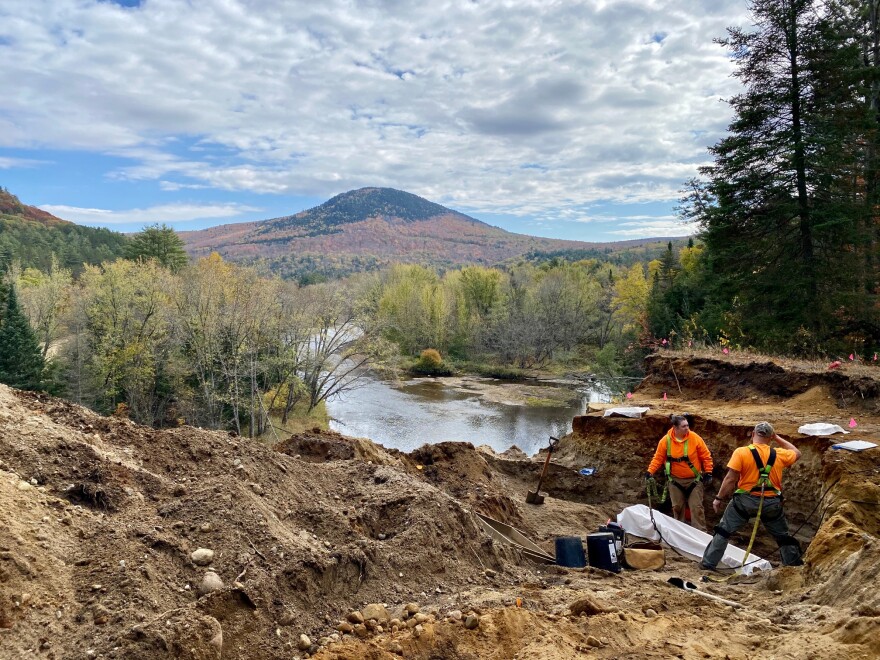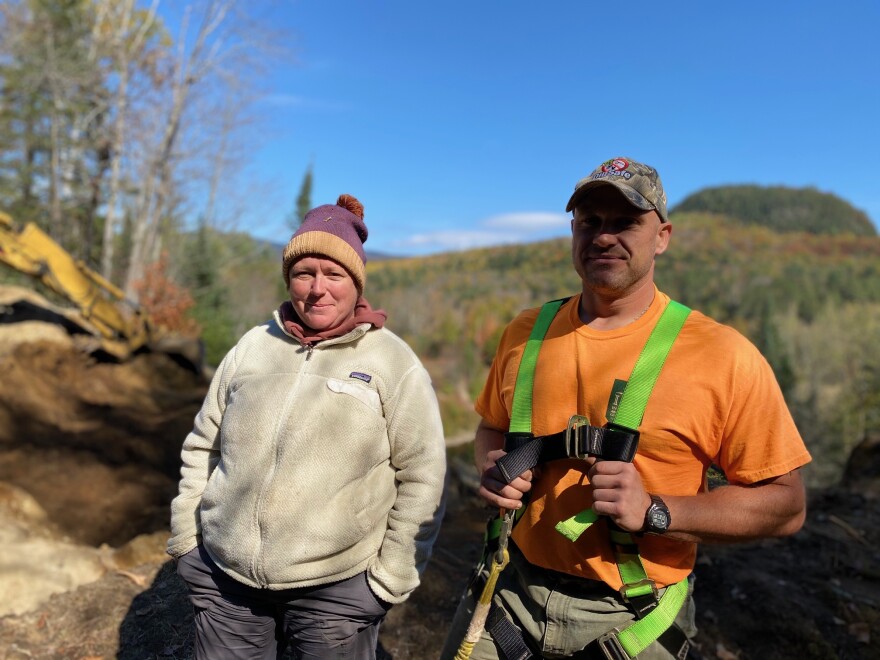In Stark, a small cliffside cemetery has been eroding into the Ammonoosuc for years – and both earth and bones have been lost to the river.
During a special town meeting in mid-September, locals voted thirty-four to one in favor of relocating Blake Cemetery to a new graveyard a few miles up the road and that work has now begun.
NHPR’s Sean Hurley recently visited Stark to find out just how one goes about moving a cemetery.
Editor's note: As with all of Sean's stories, we highly recommend listening to the audio version.
When I first visited Blake, I thought it was the most beautiful cemetery I’d ever seen. Two dozen headstones in a grassy field, dangerously close to a cliffside edge high above an oxbow in the Ammonoosuc River. But three weeks into the excavation and grave retrieval and there is nothing but piles of dirt beside deeply cut trenches – not a blade of grass or headstone standing.

“We had someone stop by last week and said, ‘Oh my gosh, it looks like a bomb went off.’ But it's part of the archaeological process. It's destructive,” Jessie Cofelice says, taking me over the mounds of dirt.
Get NHPR's journalism in your inbox - sign up for our Rundown Newsletter today.
Cofelice is the co-owner of Independent Archeological Consultants out of Portsmouth and I don’t see her partner at first.
Jake Tumelaire is six feet under on hands and knees in a freshly-dug trench beside field assistant Caroline Aubry, both of them using tiny wooden tools to scrape and brush off the deeply browned, 180 year old bones of John Blake.

“Died June 15, 1840. He was 57,” Tumelaire says.
“That's the day before my birthday,” Aubry realizes. “Not 1840,” she amends and they both laugh.
Despite the intactness of the upper body, the lower remains are nothing but a stained earth they both call sacred soil. “That's kind of our term to encapsulate what we see to be maybe the spirit of that person in the absence of remains,” Tumelaire explains, “so at least we have something to reinter.”
Tumelaire says this kind of care and collection - of the there and the not quite there - speaks to the larger nature of this work. “It's science and spirituality altogether,” he says.

Not everything is easy to find, and Tumelaire hauls out buckets of dirt to screen to make sure there’s nothing else hiding in the earth around the coffin – which itself has been compressed by the weight of the soil into an area just three inches high.
“Mostly just nails, chunks of wood,” Tumelaire says as he drags a trowel through the sifter and finds a fragment of John Blake’s coffin. “Some of it, you can see there's actually intact wood grain in that piece? Right there. Some of it's just pieces of stained dirt.”

Everything from rotten bits of coffin wood to the dark sacred soil is carefully transferred into a newly made pine coffin, bedded in hay, and wrapped in linen.

So far, with the help of Bryant Funeral Home, which comes every day at 3:45 to collect the coffins, they’ve transferred about twenty bodies to Emerson Cemetery.
“A team of two will get two out per day,” Tumelaire says, “with, you know, Leo's help, that's key, obviously!”

Leo is Leo Chaloux, a Stark resident with his own excavating business. He says he’s excavated all over the state for almost every kind of reason, but he’s never dug out a graveyard.
“Never did one before,” Chaloux says. “And it's 100 years old. It's not like something fresh, you know, it's just, it's been there for years and years and years. As far as I'm concerned, I'm glad that they’re moving them to another cemetery so they don't all end up in a river, you know?”
Support the local newsroom that makes stories like this one...become an NHPR member today.
When I first visited, the gravestone tally stood at 27. Cofelice and Tumelaire have since found one additional headstone buried below the grass. A ground penetrating radar scan conducted earlier this summer revealed an additional 20 possible coffins.
“And I want to say in eight to ten locations we've identified graves,” Cofelice tells me, “and then the rest are undulating gravel veins or rotten root stumps.”
Which means they’ve so far retrieved ten bodies from unmarked graves - children most likely, Cofelice believes - a not unusual burial practice in the 1800’s.
“We've had a mix of the hexagonal coffins and rectangular coffins,” Cofelice says. “We've got viewing glass plates, hinges, handles, cap lifters, not too much in the way of decorative embellishments.”
In her twenty years of cemetery work, Cofelice has only found two rings. Things of value are almost always passed on as heirlooms.

So far the team of five hasn’t found much in the way of personal effects. “In two instances we've had traces of suit jackets with just the lapels, where you've got a double layer of fabric present,” Cofelice says. “We had one comb in hair, and then some decorative buttons on one of the female individuals. But that's about it.”
As Cofelice watches Leo Chaloux scrape a foot of dirt above one of the anomalous ground penetrating radar findings, she points to a just revealed square of slightly brighter earth. Signs of a graveshaft, she’s sure.
“Yeah, there's a little one right here,” Cofelice says. “Looks like maybe a child. This is the hardest part for me. This is the most nerve wracking part. Cause you want to make sure you don't miss anybody. See how subtle it is? If you don't know what you're looking for, it's really tough to pick them out.”

As Cofelice flags the corners of the grave shaft and Leo Chaloux prepares to dig a channel beside it, Jake Tumelaire and Caroline Aubry carry John Blake’s coffin out of the trench and set it down near the pile of headstones.

This, Jessie Cofelice says, is work that stays with you.
“I remember every individual that we take out of the ground and I can remember graves that I've disinterred and excavated a decade ago,” she says. “I mean, you take it very personally.”

In the spring, in the southwest corner of Emerson Cemetery, the new Blake Cemetery will be opened during a public ceremony that Jessie Cofelice and her team are planning to attend.







